Employment as a Tool: Tackling Terrorism & Social Vices in Australia
VerifiedAdded on 2024/04/26
|10
|3256
|116
Essay
AI Summary
This essay explores the relationship between low unemployment rates and low terrorism rates in Australia, arguing that ample employment opportunities have helped prevent terrorism compared to other developed and underdeveloped countries. It examines how employment acts as a tool for addressing terrorism and social vices, referencing the 'Australian model' of generating employment to decrease terrorist activities. The essay compares terrorism activities and employment rates across various nations, including the United States, Canada, the United Kingdom, Nigeria, Kenya, Pakistan, India, Afghanistan, and Thailand, to establish a link between employment opportunities and the occurrence of terror events. It highlights Australia's success in avoiding significant terrorist attacks due to its economic stability and high employment rates, contrasting it with countries that have experienced higher levels of terrorism.
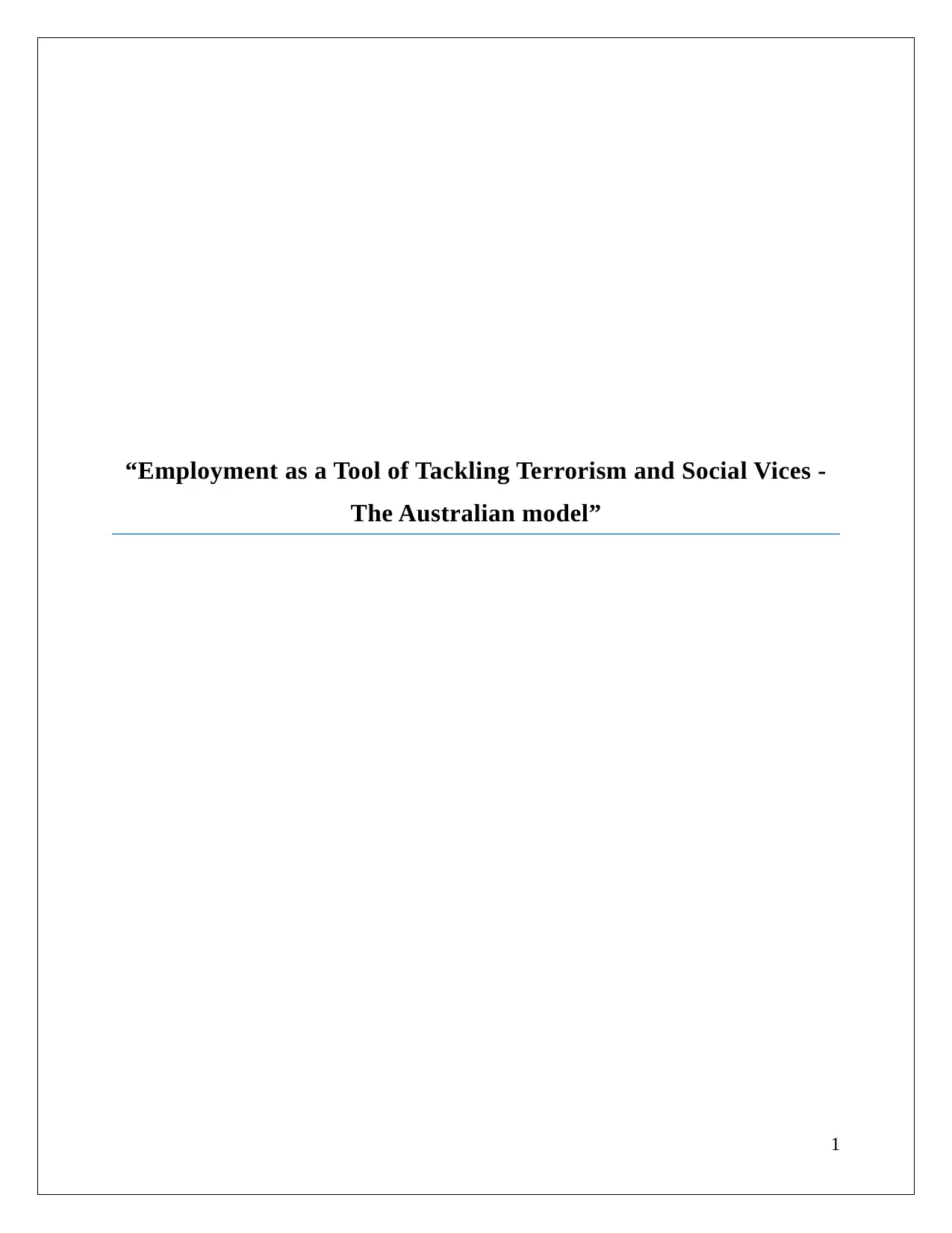
“Employment as a Tool of Tackling Terrorism and Social Vices -
The Australian model”
1
The Australian model”
1
Paraphrase This Document
Need a fresh take? Get an instant paraphrase of this document with our AI Paraphraser

Table of Contents
Introduction......................................................................................................................................3
Discussion........................................................................................................................................4
Conclusion.......................................................................................................................................8
References........................................................................................................................................9
2
Introduction......................................................................................................................................3
Discussion........................................................................................................................................4
Conclusion.......................................................................................................................................8
References........................................................................................................................................9
2
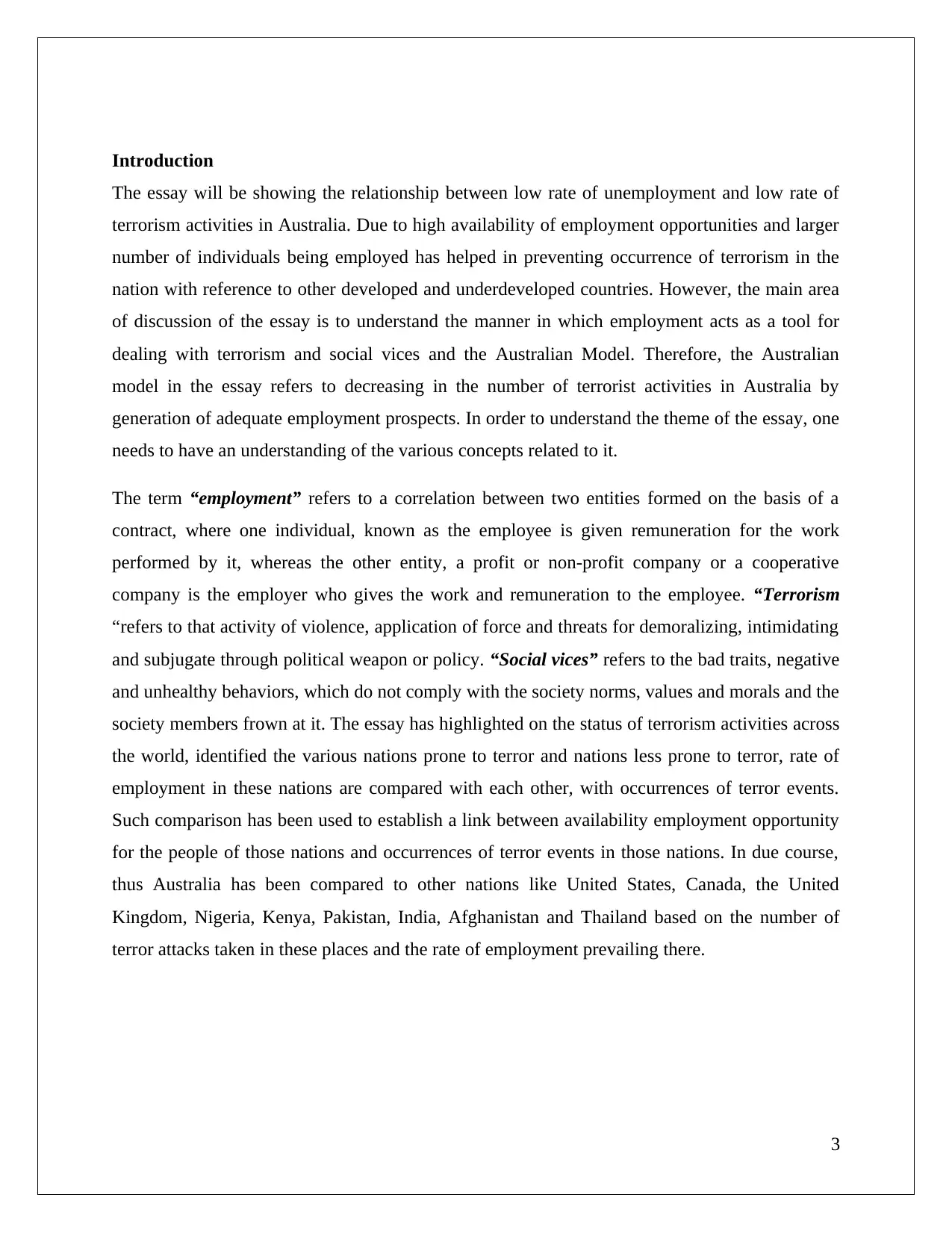
Introduction
The essay will be showing the relationship between low rate of unemployment and low rate of
terrorism activities in Australia. Due to high availability of employment opportunities and larger
number of individuals being employed has helped in preventing occurrence of terrorism in the
nation with reference to other developed and underdeveloped countries. However, the main area
of discussion of the essay is to understand the manner in which employment acts as a tool for
dealing with terrorism and social vices and the Australian Model. Therefore, the Australian
model in the essay refers to decreasing in the number of terrorist activities in Australia by
generation of adequate employment prospects. In order to understand the theme of the essay, one
needs to have an understanding of the various concepts related to it.
The term “employment” refers to a correlation between two entities formed on the basis of a
contract, where one individual, known as the employee is given remuneration for the work
performed by it, whereas the other entity, a profit or non-profit company or a cooperative
company is the employer who gives the work and remuneration to the employee. “Terrorism
“refers to that activity of violence, application of force and threats for demoralizing, intimidating
and subjugate through political weapon or policy. “Social vices” refers to the bad traits, negative
and unhealthy behaviors, which do not comply with the society norms, values and morals and the
society members frown at it. The essay has highlighted on the status of terrorism activities across
the world, identified the various nations prone to terror and nations less prone to terror, rate of
employment in these nations are compared with each other, with occurrences of terror events.
Such comparison has been used to establish a link between availability employment opportunity
for the people of those nations and occurrences of terror events in those nations. In due course,
thus Australia has been compared to other nations like United States, Canada, the United
Kingdom, Nigeria, Kenya, Pakistan, India, Afghanistan and Thailand based on the number of
terror attacks taken in these places and the rate of employment prevailing there.
3
The essay will be showing the relationship between low rate of unemployment and low rate of
terrorism activities in Australia. Due to high availability of employment opportunities and larger
number of individuals being employed has helped in preventing occurrence of terrorism in the
nation with reference to other developed and underdeveloped countries. However, the main area
of discussion of the essay is to understand the manner in which employment acts as a tool for
dealing with terrorism and social vices and the Australian Model. Therefore, the Australian
model in the essay refers to decreasing in the number of terrorist activities in Australia by
generation of adequate employment prospects. In order to understand the theme of the essay, one
needs to have an understanding of the various concepts related to it.
The term “employment” refers to a correlation between two entities formed on the basis of a
contract, where one individual, known as the employee is given remuneration for the work
performed by it, whereas the other entity, a profit or non-profit company or a cooperative
company is the employer who gives the work and remuneration to the employee. “Terrorism
“refers to that activity of violence, application of force and threats for demoralizing, intimidating
and subjugate through political weapon or policy. “Social vices” refers to the bad traits, negative
and unhealthy behaviors, which do not comply with the society norms, values and morals and the
society members frown at it. The essay has highlighted on the status of terrorism activities across
the world, identified the various nations prone to terror and nations less prone to terror, rate of
employment in these nations are compared with each other, with occurrences of terror events.
Such comparison has been used to establish a link between availability employment opportunity
for the people of those nations and occurrences of terror events in those nations. In due course,
thus Australia has been compared to other nations like United States, Canada, the United
Kingdom, Nigeria, Kenya, Pakistan, India, Afghanistan and Thailand based on the number of
terror attacks taken in these places and the rate of employment prevailing there.
3
⊘ This is a preview!⊘
Do you want full access?
Subscribe today to unlock all pages.

Trusted by 1+ million students worldwide
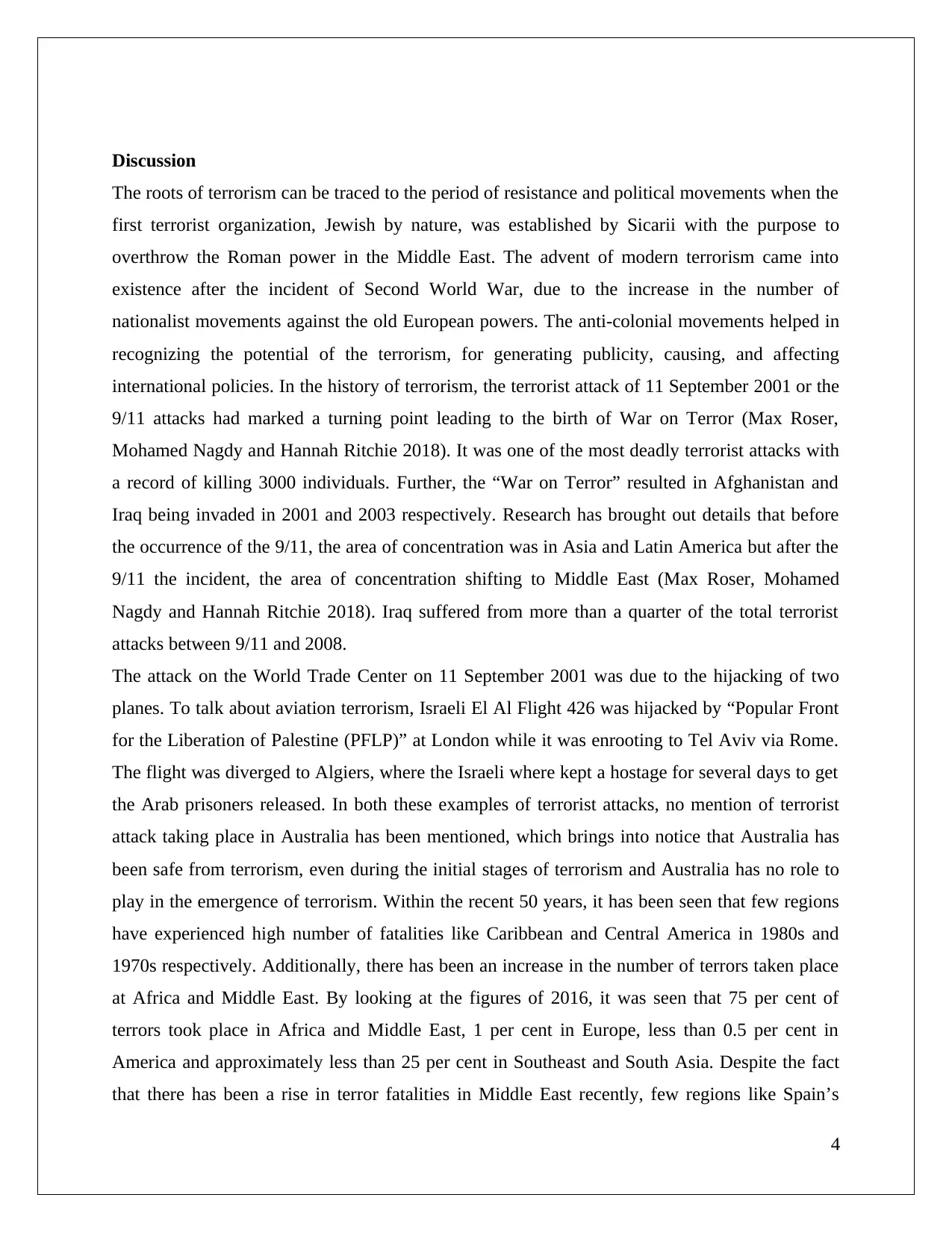
Discussion
The roots of terrorism can be traced to the period of resistance and political movements when the
first terrorist organization, Jewish by nature, was established by Sicarii with the purpose to
overthrow the Roman power in the Middle East. The advent of modern terrorism came into
existence after the incident of Second World War, due to the increase in the number of
nationalist movements against the old European powers. The anti-colonial movements helped in
recognizing the potential of the terrorism, for generating publicity, causing, and affecting
international policies. In the history of terrorism, the terrorist attack of 11 September 2001 or the
9/11 attacks had marked a turning point leading to the birth of War on Terror (Max Roser,
Mohamed Nagdy and Hannah Ritchie 2018). It was one of the most deadly terrorist attacks with
a record of killing 3000 individuals. Further, the “War on Terror” resulted in Afghanistan and
Iraq being invaded in 2001 and 2003 respectively. Research has brought out details that before
the occurrence of the 9/11, the area of concentration was in Asia and Latin America but after the
9/11 the incident, the area of concentration shifting to Middle East (Max Roser, Mohamed
Nagdy and Hannah Ritchie 2018). Iraq suffered from more than a quarter of the total terrorist
attacks between 9/11 and 2008.
The attack on the World Trade Center on 11 September 2001 was due to the hijacking of two
planes. To talk about aviation terrorism, Israeli El Al Flight 426 was hijacked by “Popular Front
for the Liberation of Palestine (PFLP)” at London while it was enrooting to Tel Aviv via Rome.
The flight was diverged to Algiers, where the Israeli where kept a hostage for several days to get
the Arab prisoners released. In both these examples of terrorist attacks, no mention of terrorist
attack taking place in Australia has been mentioned, which brings into notice that Australia has
been safe from terrorism, even during the initial stages of terrorism and Australia has no role to
play in the emergence of terrorism. Within the recent 50 years, it has been seen that few regions
have experienced high number of fatalities like Caribbean and Central America in 1980s and
1970s respectively. Additionally, there has been an increase in the number of terrors taken place
at Africa and Middle East. By looking at the figures of 2016, it was seen that 75 per cent of
terrors took place in Africa and Middle East, 1 per cent in Europe, less than 0.5 per cent in
America and approximately less than 25 per cent in Southeast and South Asia. Despite the fact
that there has been a rise in terror fatalities in Middle East recently, few regions like Spain’s
4
The roots of terrorism can be traced to the period of resistance and political movements when the
first terrorist organization, Jewish by nature, was established by Sicarii with the purpose to
overthrow the Roman power in the Middle East. The advent of modern terrorism came into
existence after the incident of Second World War, due to the increase in the number of
nationalist movements against the old European powers. The anti-colonial movements helped in
recognizing the potential of the terrorism, for generating publicity, causing, and affecting
international policies. In the history of terrorism, the terrorist attack of 11 September 2001 or the
9/11 attacks had marked a turning point leading to the birth of War on Terror (Max Roser,
Mohamed Nagdy and Hannah Ritchie 2018). It was one of the most deadly terrorist attacks with
a record of killing 3000 individuals. Further, the “War on Terror” resulted in Afghanistan and
Iraq being invaded in 2001 and 2003 respectively. Research has brought out details that before
the occurrence of the 9/11, the area of concentration was in Asia and Latin America but after the
9/11 the incident, the area of concentration shifting to Middle East (Max Roser, Mohamed
Nagdy and Hannah Ritchie 2018). Iraq suffered from more than a quarter of the total terrorist
attacks between 9/11 and 2008.
The attack on the World Trade Center on 11 September 2001 was due to the hijacking of two
planes. To talk about aviation terrorism, Israeli El Al Flight 426 was hijacked by “Popular Front
for the Liberation of Palestine (PFLP)” at London while it was enrooting to Tel Aviv via Rome.
The flight was diverged to Algiers, where the Israeli where kept a hostage for several days to get
the Arab prisoners released. In both these examples of terrorist attacks, no mention of terrorist
attack taking place in Australia has been mentioned, which brings into notice that Australia has
been safe from terrorism, even during the initial stages of terrorism and Australia has no role to
play in the emergence of terrorism. Within the recent 50 years, it has been seen that few regions
have experienced high number of fatalities like Caribbean and Central America in 1980s and
1970s respectively. Additionally, there has been an increase in the number of terrors taken place
at Africa and Middle East. By looking at the figures of 2016, it was seen that 75 per cent of
terrors took place in Africa and Middle East, 1 per cent in Europe, less than 0.5 per cent in
America and approximately less than 25 per cent in Southeast and South Asia. Despite the fact
that there has been a rise in terror fatalities in Middle East recently, few regions like Spain’s
4
Paraphrase This Document
Need a fresh take? Get an instant paraphrase of this document with our AI Paraphraser
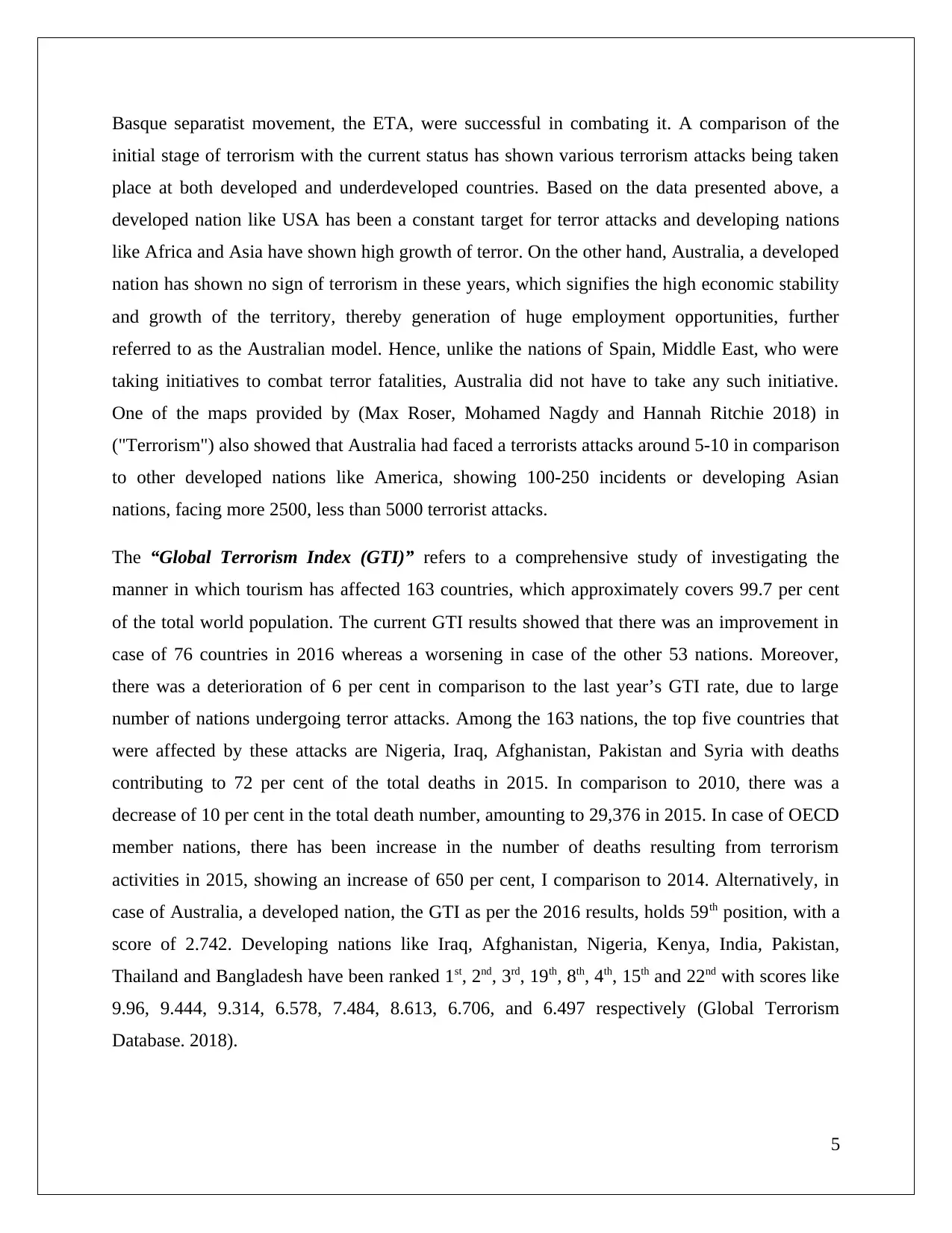
Basque separatist movement, the ETA, were successful in combating it. A comparison of the
initial stage of terrorism with the current status has shown various terrorism attacks being taken
place at both developed and underdeveloped countries. Based on the data presented above, a
developed nation like USA has been a constant target for terror attacks and developing nations
like Africa and Asia have shown high growth of terror. On the other hand, Australia, a developed
nation has shown no sign of terrorism in these years, which signifies the high economic stability
and growth of the territory, thereby generation of huge employment opportunities, further
referred to as the Australian model. Hence, unlike the nations of Spain, Middle East, who were
taking initiatives to combat terror fatalities, Australia did not have to take any such initiative.
One of the maps provided by (Max Roser, Mohamed Nagdy and Hannah Ritchie 2018) in
("Terrorism") also showed that Australia had faced a terrorists attacks around 5-10 in comparison
to other developed nations like America, showing 100-250 incidents or developing Asian
nations, facing more 2500, less than 5000 terrorist attacks.
The “Global Terrorism Index (GTI)” refers to a comprehensive study of investigating the
manner in which tourism has affected 163 countries, which approximately covers 99.7 per cent
of the total world population. The current GTI results showed that there was an improvement in
case of 76 countries in 2016 whereas a worsening in case of the other 53 nations. Moreover,
there was a deterioration of 6 per cent in comparison to the last year’s GTI rate, due to large
number of nations undergoing terror attacks. Among the 163 nations, the top five countries that
were affected by these attacks are Nigeria, Iraq, Afghanistan, Pakistan and Syria with deaths
contributing to 72 per cent of the total deaths in 2015. In comparison to 2010, there was a
decrease of 10 per cent in the total death number, amounting to 29,376 in 2015. In case of OECD
member nations, there has been increase in the number of deaths resulting from terrorism
activities in 2015, showing an increase of 650 per cent, I comparison to 2014. Alternatively, in
case of Australia, a developed nation, the GTI as per the 2016 results, holds 59th position, with a
score of 2.742. Developing nations like Iraq, Afghanistan, Nigeria, Kenya, India, Pakistan,
Thailand and Bangladesh have been ranked 1st, 2nd, 3rd, 19th, 8th, 4th, 15th and 22nd with scores like
9.96, 9.444, 9.314, 6.578, 7.484, 8.613, 6.706, and 6.497 respectively (Global Terrorism
Database. 2018).
5
initial stage of terrorism with the current status has shown various terrorism attacks being taken
place at both developed and underdeveloped countries. Based on the data presented above, a
developed nation like USA has been a constant target for terror attacks and developing nations
like Africa and Asia have shown high growth of terror. On the other hand, Australia, a developed
nation has shown no sign of terrorism in these years, which signifies the high economic stability
and growth of the territory, thereby generation of huge employment opportunities, further
referred to as the Australian model. Hence, unlike the nations of Spain, Middle East, who were
taking initiatives to combat terror fatalities, Australia did not have to take any such initiative.
One of the maps provided by (Max Roser, Mohamed Nagdy and Hannah Ritchie 2018) in
("Terrorism") also showed that Australia had faced a terrorists attacks around 5-10 in comparison
to other developed nations like America, showing 100-250 incidents or developing Asian
nations, facing more 2500, less than 5000 terrorist attacks.
The “Global Terrorism Index (GTI)” refers to a comprehensive study of investigating the
manner in which tourism has affected 163 countries, which approximately covers 99.7 per cent
of the total world population. The current GTI results showed that there was an improvement in
case of 76 countries in 2016 whereas a worsening in case of the other 53 nations. Moreover,
there was a deterioration of 6 per cent in comparison to the last year’s GTI rate, due to large
number of nations undergoing terror attacks. Among the 163 nations, the top five countries that
were affected by these attacks are Nigeria, Iraq, Afghanistan, Pakistan and Syria with deaths
contributing to 72 per cent of the total deaths in 2015. In comparison to 2010, there was a
decrease of 10 per cent in the total death number, amounting to 29,376 in 2015. In case of OECD
member nations, there has been increase in the number of deaths resulting from terrorism
activities in 2015, showing an increase of 650 per cent, I comparison to 2014. Alternatively, in
case of Australia, a developed nation, the GTI as per the 2016 results, holds 59th position, with a
score of 2.742. Developing nations like Iraq, Afghanistan, Nigeria, Kenya, India, Pakistan,
Thailand and Bangladesh have been ranked 1st, 2nd, 3rd, 19th, 8th, 4th, 15th and 22nd with scores like
9.96, 9.444, 9.314, 6.578, 7.484, 8.613, 6.706, and 6.497 respectively (Global Terrorism
Database. 2018).
5
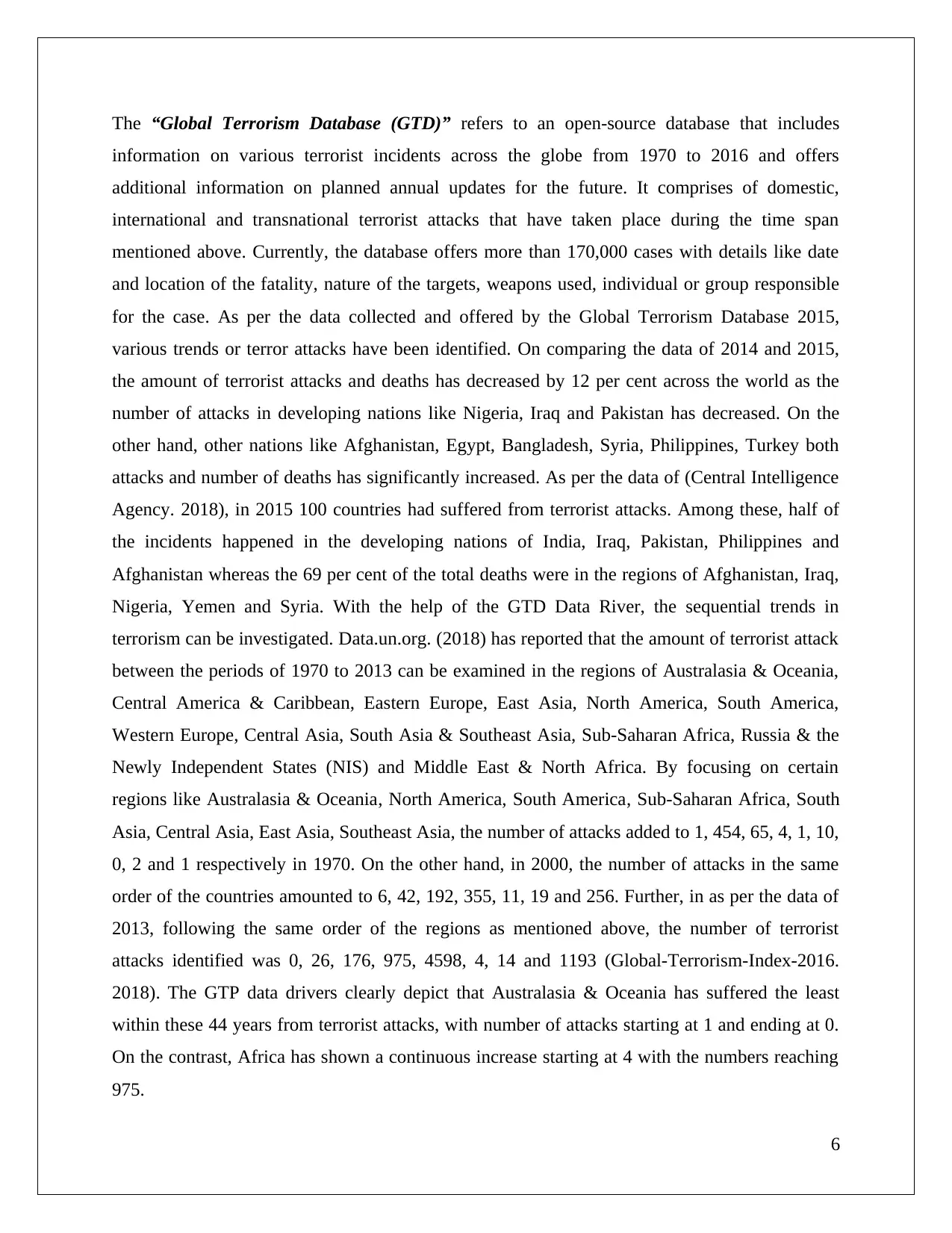
The “Global Terrorism Database (GTD)” refers to an open-source database that includes
information on various terrorist incidents across the globe from 1970 to 2016 and offers
additional information on planned annual updates for the future. It comprises of domestic,
international and transnational terrorist attacks that have taken place during the time span
mentioned above. Currently, the database offers more than 170,000 cases with details like date
and location of the fatality, nature of the targets, weapons used, individual or group responsible
for the case. As per the data collected and offered by the Global Terrorism Database 2015,
various trends or terror attacks have been identified. On comparing the data of 2014 and 2015,
the amount of terrorist attacks and deaths has decreased by 12 per cent across the world as the
number of attacks in developing nations like Nigeria, Iraq and Pakistan has decreased. On the
other hand, other nations like Afghanistan, Egypt, Bangladesh, Syria, Philippines, Turkey both
attacks and number of deaths has significantly increased. As per the data of (Central Intelligence
Agency. 2018), in 2015 100 countries had suffered from terrorist attacks. Among these, half of
the incidents happened in the developing nations of India, Iraq, Pakistan, Philippines and
Afghanistan whereas the 69 per cent of the total deaths were in the regions of Afghanistan, Iraq,
Nigeria, Yemen and Syria. With the help of the GTD Data River, the sequential trends in
terrorism can be investigated. Data.un.org. (2018) has reported that the amount of terrorist attack
between the periods of 1970 to 2013 can be examined in the regions of Australasia & Oceania,
Central America & Caribbean, Eastern Europe, East Asia, North America, South America,
Western Europe, Central Asia, South Asia & Southeast Asia, Sub-Saharan Africa, Russia & the
Newly Independent States (NIS) and Middle East & North Africa. By focusing on certain
regions like Australasia & Oceania, North America, South America, Sub-Saharan Africa, South
Asia, Central Asia, East Asia, Southeast Asia, the number of attacks added to 1, 454, 65, 4, 1, 10,
0, 2 and 1 respectively in 1970. On the other hand, in 2000, the number of attacks in the same
order of the countries amounted to 6, 42, 192, 355, 11, 19 and 256. Further, in as per the data of
2013, following the same order of the regions as mentioned above, the number of terrorist
attacks identified was 0, 26, 176, 975, 4598, 4, 14 and 1193 (Global-Terrorism-Index-2016.
2018). The GTP data drivers clearly depict that Australasia & Oceania has suffered the least
within these 44 years from terrorist attacks, with number of attacks starting at 1 and ending at 0.
On the contrast, Africa has shown a continuous increase starting at 4 with the numbers reaching
975.
6
information on various terrorist incidents across the globe from 1970 to 2016 and offers
additional information on planned annual updates for the future. It comprises of domestic,
international and transnational terrorist attacks that have taken place during the time span
mentioned above. Currently, the database offers more than 170,000 cases with details like date
and location of the fatality, nature of the targets, weapons used, individual or group responsible
for the case. As per the data collected and offered by the Global Terrorism Database 2015,
various trends or terror attacks have been identified. On comparing the data of 2014 and 2015,
the amount of terrorist attacks and deaths has decreased by 12 per cent across the world as the
number of attacks in developing nations like Nigeria, Iraq and Pakistan has decreased. On the
other hand, other nations like Afghanistan, Egypt, Bangladesh, Syria, Philippines, Turkey both
attacks and number of deaths has significantly increased. As per the data of (Central Intelligence
Agency. 2018), in 2015 100 countries had suffered from terrorist attacks. Among these, half of
the incidents happened in the developing nations of India, Iraq, Pakistan, Philippines and
Afghanistan whereas the 69 per cent of the total deaths were in the regions of Afghanistan, Iraq,
Nigeria, Yemen and Syria. With the help of the GTD Data River, the sequential trends in
terrorism can be investigated. Data.un.org. (2018) has reported that the amount of terrorist attack
between the periods of 1970 to 2013 can be examined in the regions of Australasia & Oceania,
Central America & Caribbean, Eastern Europe, East Asia, North America, South America,
Western Europe, Central Asia, South Asia & Southeast Asia, Sub-Saharan Africa, Russia & the
Newly Independent States (NIS) and Middle East & North Africa. By focusing on certain
regions like Australasia & Oceania, North America, South America, Sub-Saharan Africa, South
Asia, Central Asia, East Asia, Southeast Asia, the number of attacks added to 1, 454, 65, 4, 1, 10,
0, 2 and 1 respectively in 1970. On the other hand, in 2000, the number of attacks in the same
order of the countries amounted to 6, 42, 192, 355, 11, 19 and 256. Further, in as per the data of
2013, following the same order of the regions as mentioned above, the number of terrorist
attacks identified was 0, 26, 176, 975, 4598, 4, 14 and 1193 (Global-Terrorism-Index-2016.
2018). The GTP data drivers clearly depict that Australasia & Oceania has suffered the least
within these 44 years from terrorist attacks, with number of attacks starting at 1 and ending at 0.
On the contrast, Africa has shown a continuous increase starting at 4 with the numbers reaching
975.
6
⊘ This is a preview!⊘
Do you want full access?
Subscribe today to unlock all pages.

Trusted by 1+ million students worldwide
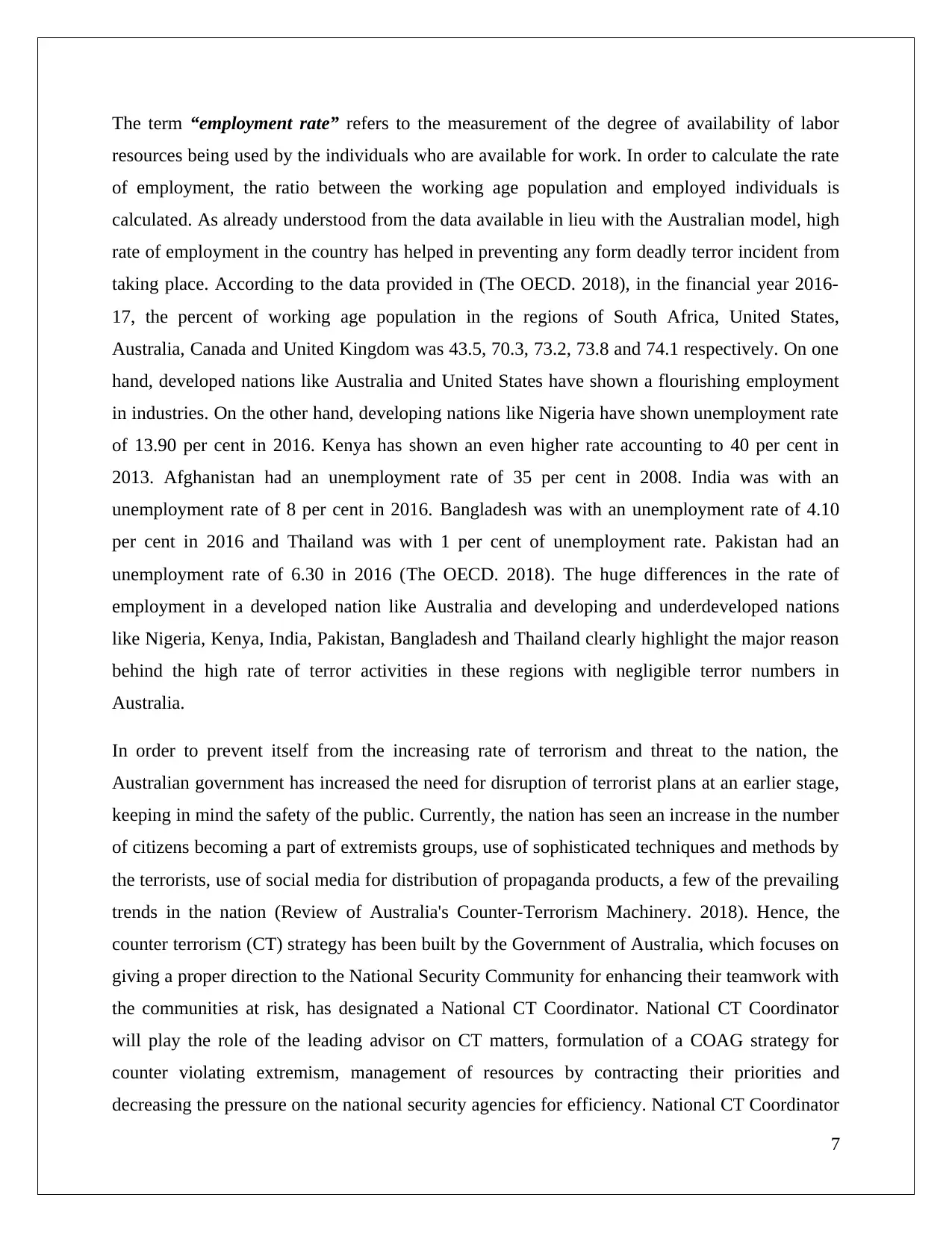
The term “employment rate” refers to the measurement of the degree of availability of labor
resources being used by the individuals who are available for work. In order to calculate the rate
of employment, the ratio between the working age population and employed individuals is
calculated. As already understood from the data available in lieu with the Australian model, high
rate of employment in the country has helped in preventing any form deadly terror incident from
taking place. According to the data provided in (The OECD. 2018), in the financial year 2016-
17, the percent of working age population in the regions of South Africa, United States,
Australia, Canada and United Kingdom was 43.5, 70.3, 73.2, 73.8 and 74.1 respectively. On one
hand, developed nations like Australia and United States have shown a flourishing employment
in industries. On the other hand, developing nations like Nigeria have shown unemployment rate
of 13.90 per cent in 2016. Kenya has shown an even higher rate accounting to 40 per cent in
2013. Afghanistan had an unemployment rate of 35 per cent in 2008. India was with an
unemployment rate of 8 per cent in 2016. Bangladesh was with an unemployment rate of 4.10
per cent in 2016 and Thailand was with 1 per cent of unemployment rate. Pakistan had an
unemployment rate of 6.30 in 2016 (The OECD. 2018). The huge differences in the rate of
employment in a developed nation like Australia and developing and underdeveloped nations
like Nigeria, Kenya, India, Pakistan, Bangladesh and Thailand clearly highlight the major reason
behind the high rate of terror activities in these regions with negligible terror numbers in
Australia.
In order to prevent itself from the increasing rate of terrorism and threat to the nation, the
Australian government has increased the need for disruption of terrorist plans at an earlier stage,
keeping in mind the safety of the public. Currently, the nation has seen an increase in the number
of citizens becoming a part of extremists groups, use of sophisticated techniques and methods by
the terrorists, use of social media for distribution of propaganda products, a few of the prevailing
trends in the nation (Review of Australia's Counter-Terrorism Machinery. 2018). Hence, the
counter terrorism (CT) strategy has been built by the Government of Australia, which focuses on
giving a proper direction to the National Security Community for enhancing their teamwork with
the communities at risk, has designated a National CT Coordinator. National CT Coordinator
will play the role of the leading advisor on CT matters, formulation of a COAG strategy for
counter violating extremism, management of resources by contracting their priorities and
decreasing the pressure on the national security agencies for efficiency. National CT Coordinator
7
resources being used by the individuals who are available for work. In order to calculate the rate
of employment, the ratio between the working age population and employed individuals is
calculated. As already understood from the data available in lieu with the Australian model, high
rate of employment in the country has helped in preventing any form deadly terror incident from
taking place. According to the data provided in (The OECD. 2018), in the financial year 2016-
17, the percent of working age population in the regions of South Africa, United States,
Australia, Canada and United Kingdom was 43.5, 70.3, 73.2, 73.8 and 74.1 respectively. On one
hand, developed nations like Australia and United States have shown a flourishing employment
in industries. On the other hand, developing nations like Nigeria have shown unemployment rate
of 13.90 per cent in 2016. Kenya has shown an even higher rate accounting to 40 per cent in
2013. Afghanistan had an unemployment rate of 35 per cent in 2008. India was with an
unemployment rate of 8 per cent in 2016. Bangladesh was with an unemployment rate of 4.10
per cent in 2016 and Thailand was with 1 per cent of unemployment rate. Pakistan had an
unemployment rate of 6.30 in 2016 (The OECD. 2018). The huge differences in the rate of
employment in a developed nation like Australia and developing and underdeveloped nations
like Nigeria, Kenya, India, Pakistan, Bangladesh and Thailand clearly highlight the major reason
behind the high rate of terror activities in these regions with negligible terror numbers in
Australia.
In order to prevent itself from the increasing rate of terrorism and threat to the nation, the
Australian government has increased the need for disruption of terrorist plans at an earlier stage,
keeping in mind the safety of the public. Currently, the nation has seen an increase in the number
of citizens becoming a part of extremists groups, use of sophisticated techniques and methods by
the terrorists, use of social media for distribution of propaganda products, a few of the prevailing
trends in the nation (Review of Australia's Counter-Terrorism Machinery. 2018). Hence, the
counter terrorism (CT) strategy has been built by the Government of Australia, which focuses on
giving a proper direction to the National Security Community for enhancing their teamwork with
the communities at risk, has designated a National CT Coordinator. National CT Coordinator
will play the role of the leading advisor on CT matters, formulation of a COAG strategy for
counter violating extremism, management of resources by contracting their priorities and
decreasing the pressure on the national security agencies for efficiency. National CT Coordinator
7
Paraphrase This Document
Need a fresh take? Get an instant paraphrase of this document with our AI Paraphraser
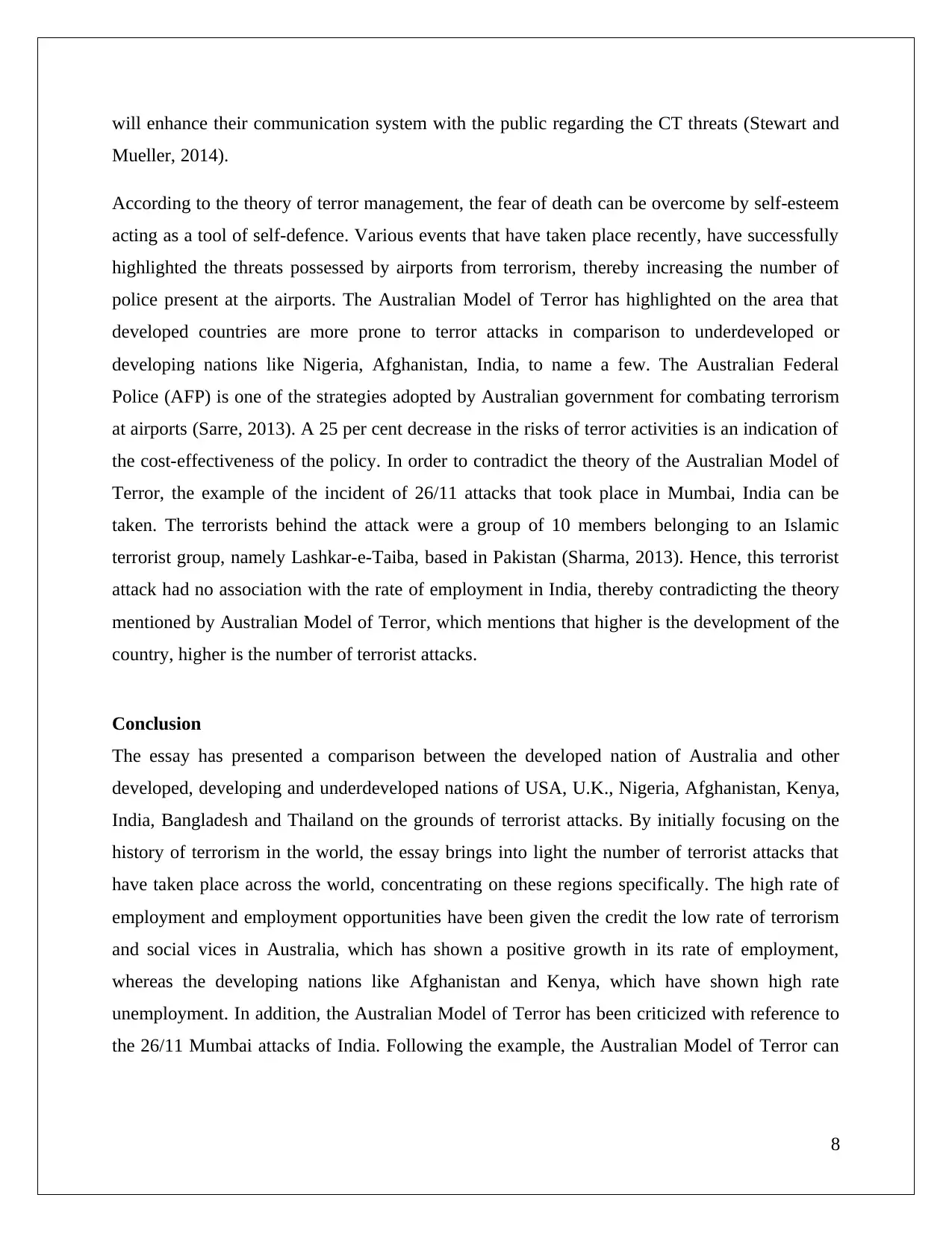
will enhance their communication system with the public regarding the CT threats (Stewart and
Mueller, 2014).
According to the theory of terror management, the fear of death can be overcome by self-esteem
acting as a tool of self-defence. Various events that have taken place recently, have successfully
highlighted the threats possessed by airports from terrorism, thereby increasing the number of
police present at the airports. The Australian Model of Terror has highlighted on the area that
developed countries are more prone to terror attacks in comparison to underdeveloped or
developing nations like Nigeria, Afghanistan, India, to name a few. The Australian Federal
Police (AFP) is one of the strategies adopted by Australian government for combating terrorism
at airports (Sarre, 2013). A 25 per cent decrease in the risks of terror activities is an indication of
the cost-effectiveness of the policy. In order to contradict the theory of the Australian Model of
Terror, the example of the incident of 26/11 attacks that took place in Mumbai, India can be
taken. The terrorists behind the attack were a group of 10 members belonging to an Islamic
terrorist group, namely Lashkar-e-Taiba, based in Pakistan (Sharma, 2013). Hence, this terrorist
attack had no association with the rate of employment in India, thereby contradicting the theory
mentioned by Australian Model of Terror, which mentions that higher is the development of the
country, higher is the number of terrorist attacks.
Conclusion
The essay has presented a comparison between the developed nation of Australia and other
developed, developing and underdeveloped nations of USA, U.K., Nigeria, Afghanistan, Kenya,
India, Bangladesh and Thailand on the grounds of terrorist attacks. By initially focusing on the
history of terrorism in the world, the essay brings into light the number of terrorist attacks that
have taken place across the world, concentrating on these regions specifically. The high rate of
employment and employment opportunities have been given the credit the low rate of terrorism
and social vices in Australia, which has shown a positive growth in its rate of employment,
whereas the developing nations like Afghanistan and Kenya, which have shown high rate
unemployment. In addition, the Australian Model of Terror has been criticized with reference to
the 26/11 Mumbai attacks of India. Following the example, the Australian Model of Terror can
8
Mueller, 2014).
According to the theory of terror management, the fear of death can be overcome by self-esteem
acting as a tool of self-defence. Various events that have taken place recently, have successfully
highlighted the threats possessed by airports from terrorism, thereby increasing the number of
police present at the airports. The Australian Model of Terror has highlighted on the area that
developed countries are more prone to terror attacks in comparison to underdeveloped or
developing nations like Nigeria, Afghanistan, India, to name a few. The Australian Federal
Police (AFP) is one of the strategies adopted by Australian government for combating terrorism
at airports (Sarre, 2013). A 25 per cent decrease in the risks of terror activities is an indication of
the cost-effectiveness of the policy. In order to contradict the theory of the Australian Model of
Terror, the example of the incident of 26/11 attacks that took place in Mumbai, India can be
taken. The terrorists behind the attack were a group of 10 members belonging to an Islamic
terrorist group, namely Lashkar-e-Taiba, based in Pakistan (Sharma, 2013). Hence, this terrorist
attack had no association with the rate of employment in India, thereby contradicting the theory
mentioned by Australian Model of Terror, which mentions that higher is the development of the
country, higher is the number of terrorist attacks.
Conclusion
The essay has presented a comparison between the developed nation of Australia and other
developed, developing and underdeveloped nations of USA, U.K., Nigeria, Afghanistan, Kenya,
India, Bangladesh and Thailand on the grounds of terrorist attacks. By initially focusing on the
history of terrorism in the world, the essay brings into light the number of terrorist attacks that
have taken place across the world, concentrating on these regions specifically. The high rate of
employment and employment opportunities have been given the credit the low rate of terrorism
and social vices in Australia, which has shown a positive growth in its rate of employment,
whereas the developing nations like Afghanistan and Kenya, which have shown high rate
unemployment. In addition, the Australian Model of Terror has been criticized with reference to
the 26/11 Mumbai attacks of India. Following the example, the Australian Model of Terror can
8

be stated as imperceptible. The essay has also discussed the planned future initiatives to be
undertaken by the Australian government for combating terror in their country.
9
undertaken by the Australian government for combating terror in their country.
9
⊘ This is a preview!⊘
Do you want full access?
Subscribe today to unlock all pages.

Trusted by 1+ million students worldwide
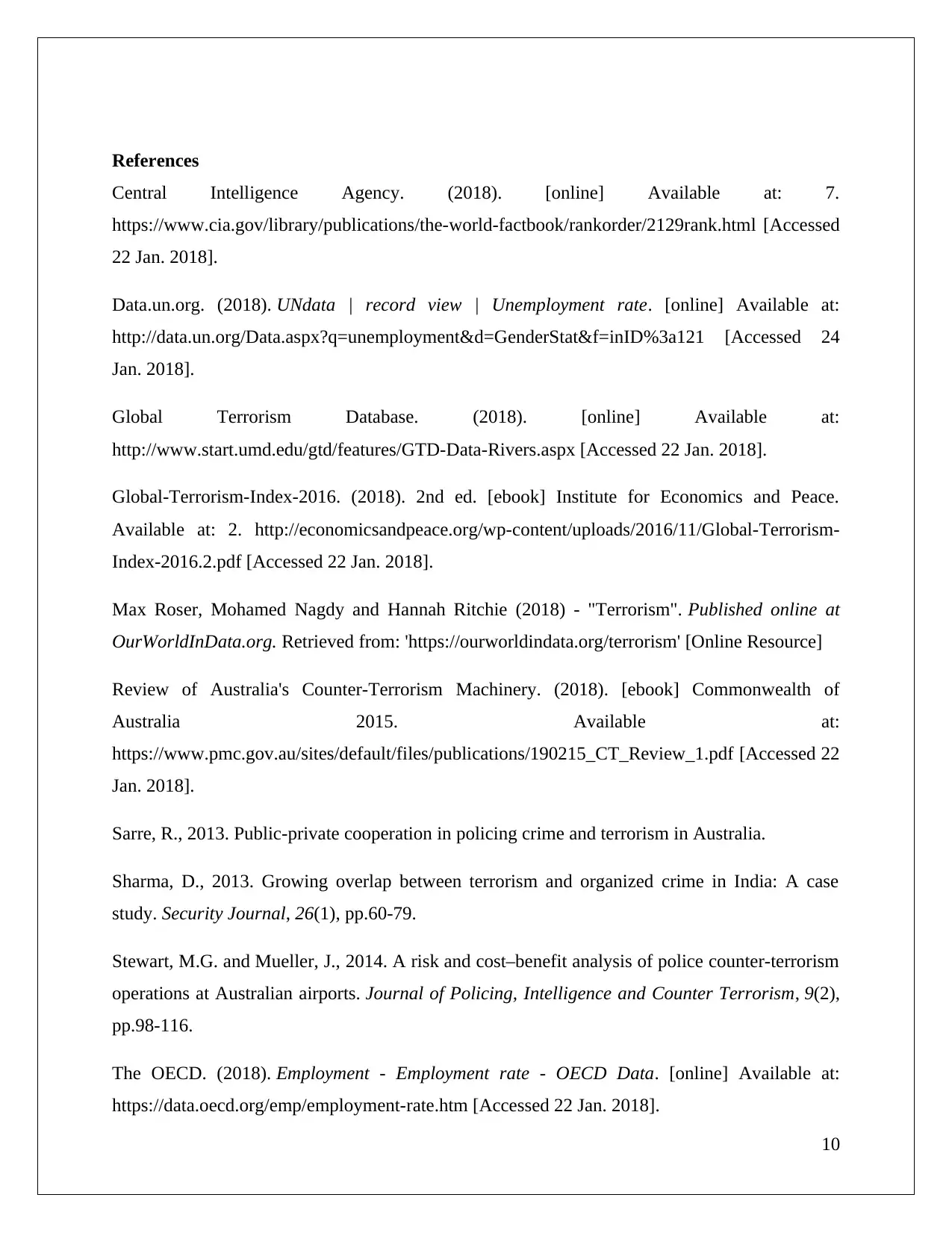
References
Central Intelligence Agency. (2018). [online] Available at: 7.
https://www.cia.gov/library/publications/the-world-factbook/rankorder/2129rank.html [Accessed
22 Jan. 2018].
Data.un.org. (2018). UNdata | record view | Unemployment rate. [online] Available at:
http://data.un.org/Data.aspx?q=unemployment&d=GenderStat&f=inID%3a121 [Accessed 24
Jan. 2018].
Global Terrorism Database. (2018). [online] Available at:
http://www.start.umd.edu/gtd/features/GTD-Data-Rivers.aspx [Accessed 22 Jan. 2018].
Global-Terrorism-Index-2016. (2018). 2nd ed. [ebook] Institute for Economics and Peace.
Available at: 2. http://economicsandpeace.org/wp-content/uploads/2016/11/Global-Terrorism-
Index-2016.2.pdf [Accessed 22 Jan. 2018].
Max Roser, Mohamed Nagdy and Hannah Ritchie (2018) - "Terrorism". Published online at
OurWorldInData.org. Retrieved from: 'https://ourworldindata.org/terrorism' [Online Resource]
Review of Australia's Counter-Terrorism Machinery. (2018). [ebook] Commonwealth of
Australia 2015. Available at:
https://www.pmc.gov.au/sites/default/files/publications/190215_CT_Review_1.pdf [Accessed 22
Jan. 2018].
Sarre, R., 2013. Public-private cooperation in policing crime and terrorism in Australia.
Sharma, D., 2013. Growing overlap between terrorism and organized crime in India: A case
study. Security Journal, 26(1), pp.60-79.
Stewart, M.G. and Mueller, J., 2014. A risk and cost–benefit analysis of police counter-terrorism
operations at Australian airports. Journal of Policing, Intelligence and Counter Terrorism, 9(2),
pp.98-116.
The OECD. (2018). Employment - Employment rate - OECD Data. [online] Available at:
https://data.oecd.org/emp/employment-rate.htm [Accessed 22 Jan. 2018].
10
Central Intelligence Agency. (2018). [online] Available at: 7.
https://www.cia.gov/library/publications/the-world-factbook/rankorder/2129rank.html [Accessed
22 Jan. 2018].
Data.un.org. (2018). UNdata | record view | Unemployment rate. [online] Available at:
http://data.un.org/Data.aspx?q=unemployment&d=GenderStat&f=inID%3a121 [Accessed 24
Jan. 2018].
Global Terrorism Database. (2018). [online] Available at:
http://www.start.umd.edu/gtd/features/GTD-Data-Rivers.aspx [Accessed 22 Jan. 2018].
Global-Terrorism-Index-2016. (2018). 2nd ed. [ebook] Institute for Economics and Peace.
Available at: 2. http://economicsandpeace.org/wp-content/uploads/2016/11/Global-Terrorism-
Index-2016.2.pdf [Accessed 22 Jan. 2018].
Max Roser, Mohamed Nagdy and Hannah Ritchie (2018) - "Terrorism". Published online at
OurWorldInData.org. Retrieved from: 'https://ourworldindata.org/terrorism' [Online Resource]
Review of Australia's Counter-Terrorism Machinery. (2018). [ebook] Commonwealth of
Australia 2015. Available at:
https://www.pmc.gov.au/sites/default/files/publications/190215_CT_Review_1.pdf [Accessed 22
Jan. 2018].
Sarre, R., 2013. Public-private cooperation in policing crime and terrorism in Australia.
Sharma, D., 2013. Growing overlap between terrorism and organized crime in India: A case
study. Security Journal, 26(1), pp.60-79.
Stewart, M.G. and Mueller, J., 2014. A risk and cost–benefit analysis of police counter-terrorism
operations at Australian airports. Journal of Policing, Intelligence and Counter Terrorism, 9(2),
pp.98-116.
The OECD. (2018). Employment - Employment rate - OECD Data. [online] Available at:
https://data.oecd.org/emp/employment-rate.htm [Accessed 22 Jan. 2018].
10
1 out of 10
Related Documents
Your All-in-One AI-Powered Toolkit for Academic Success.
+13062052269
info@desklib.com
Available 24*7 on WhatsApp / Email
![[object Object]](/_next/static/media/star-bottom.7253800d.svg)
Unlock your academic potential
Copyright © 2020–2025 A2Z Services. All Rights Reserved. Developed and managed by ZUCOL.



